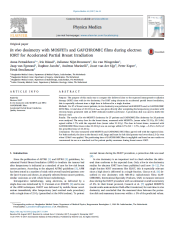Authors
AnnaPetoukhova, IrisRüssel, JulienneNijst-Brouwers, Kovan Wingerden, Jaapvan Egmond, DaphneJacobs, AndreasMarinelli, Joostvan der Sijp, PeterKoper, HenkStruikmans
Purpose
The purpose of this study was to compare the delivered dose to the expected intraoperative radiation
therapy (IORT) dose with in vivo dosimetry. For IORT using electrons in accelerated partial breast irradiation,
this is especially relevant since a high dose is delivered in a single fraction.
Methods
For 47 of breast cancer patients, in vivo dosimetry was performed with MOSFETs and/or GAFCHROMIC
EBT2 films. A total dose of 23.33 Gy at dmax was given directly after completing the lumpectomy procedure with
electron beams generated with an IORT dedicated mobile accelerator. A protection disk was used to shield the
thoracic wall.
Results
The results of in vivo MOSFET dosimetry for 27 patients and GAFROMIC film dosimetry for 20 patients
were analysed. The entry dose for the breast tissue, measured with MOSFETs, (mean value 22.3 Gy, SD 3.4%)
agreed within 1.7% with the expected dose (mean value 21.9 Gy). The dose in breast tissue, measured with
GAFCHROMIC films (mean value 23.50 Gy) was on average within 0.7% (SD=3.7%, range −5.5% to 5.6%) of
the prescribed dose of 23.33 Gy.
Conclusions
The dose measured with MOSFETs and GAFROMIC EBT2 films agreed well with the expected dose.
For both methods, the dose to the thoracic wall, lungs and heart for left sided patents was lower than 2.5 Gy even
when 12 MeV was applied. The positioning time of GAFCHROMIC films is negligible and based on our results we
recommend its use as a standard tool for patient quality assurance during breast cancer IORT.
